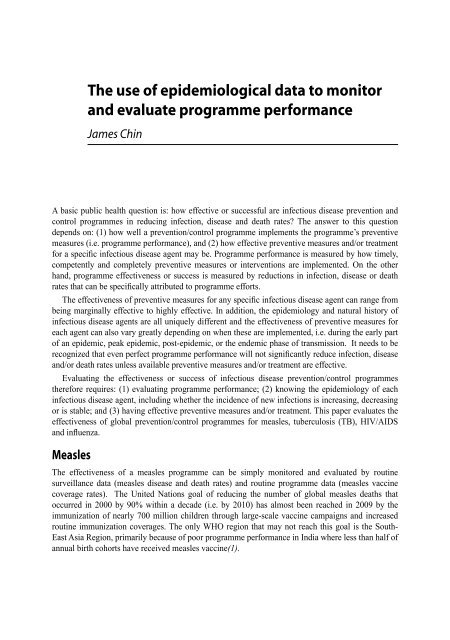South-East Asia Regional Conference on Epidemiology
South-East Asia Regional Conference on Epidemiology
South-East Asia Regional Conference on Epidemiology
Create successful ePaper yourself
Turn your PDF publications into a flip-book with our unique Google optimized e-Paper software.
The use of epidemiological data to m<strong>on</strong>itor<br />
and evaluate programme performance<br />
James Chin<br />
A basic public health questi<strong>on</strong> is: how effective or successful are infectious disease preventi<strong>on</strong> and<br />
c<strong>on</strong>trol programmes in reducing infecti<strong>on</strong>, disease and death rates? The answer to this questi<strong>on</strong><br />
depends <strong>on</strong>: (1) how well a preventi<strong>on</strong>/c<strong>on</strong>trol programme implements the programme’s preventive<br />
measures (i.e. programme performance), and (2) how effective preventive measures and/or treatment<br />
for a specific infectious disease agent may be. Programme performance is measured by how timely,<br />
competently and completely preventive measures or interventi<strong>on</strong>s are implemented. On the other<br />
hand, programme effectiveness or success is measured by reducti<strong>on</strong>s in infecti<strong>on</strong>, disease or death<br />
rates that can be specifically attributed to programme efforts.<br />
The effectiveness of preventive measures for any specific infectious disease agent can range from<br />
being marginally effective to highly effective. In additi<strong>on</strong>, the epidemiology and natural history of<br />
infectious disease agents are all uniquely different and the effectiveness of preventive measures for<br />
each agent can also vary greatly depending <strong>on</strong> when these are implemented, i.e. during the early part<br />
of an epidemic, peak epidemic, post-epidemic, or the endemic phase of transmissi<strong>on</strong>. It needs to be<br />
recognized that even perfect programme performance will not significantly reduce infecti<strong>on</strong>, disease<br />
and/or death rates unless available preventive measures and/or treatment are effective.<br />
Evaluating the effectiveness or success of infectious disease preventi<strong>on</strong>/c<strong>on</strong>trol programmes<br />
therefore requires: (1) evaluating programme performance; (2) knowing the epidemiology of each<br />
infectious disease agent, including whether the incidence of new infecti<strong>on</strong>s is increasing, decreasing<br />
or is stable; and (3) having effective preventive measures and/or treatment. This paper evaluates the<br />
effectiveness of global preventi<strong>on</strong>/c<strong>on</strong>trol programmes for measles, tuberculosis (TB), HIV/AIDS<br />
and influenza.<br />
Measles<br />
The effectiveness of a measles programme can be simply m<strong>on</strong>itored and evaluated by routine<br />
surveillance data (measles disease and death rates) and routine programme data (measles vaccine<br />
coverage rates). The United Nati<strong>on</strong>s goal of reducing the number of global measles deaths that<br />
occurred in 2000 by 90% within a decade (i.e. by 2010) has almost been reached in 2009 by the<br />
immunizati<strong>on</strong> of nearly 700 milli<strong>on</strong> children through large-scale vaccine campaigns and increased<br />
routine immunizati<strong>on</strong> coverages. The <strong>on</strong>ly WHO regi<strong>on</strong> that may not reach this goal is the <str<strong>on</strong>g>South</str<strong>on</strong>g>-<br />
<str<strong>on</strong>g>East</str<strong>on</strong>g> <str<strong>on</strong>g>Asia</str<strong>on</strong>g> Regi<strong>on</strong>, primarily because of poor programme performance in India where less than half of<br />
annual birth cohorts have received measles vaccine(1).









